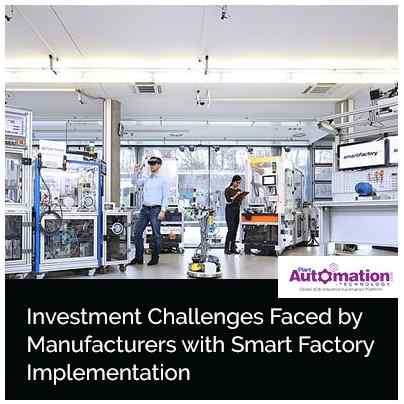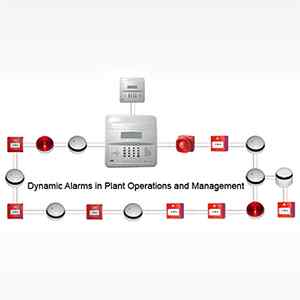Investment Challenges Faced by Manufacturers with Smart Factory Implementation

A new research paper entitled “Industry 4.0: Rising to the Challenge” has been released by Siemens Financial Services (SFS). It’s the first of a series on the investment challenges faced by manufacturers shifting their businesses to industry 4.0 technologies. With new strides and technological advancements propelling the manufacturing industry to greater innovations, it’s crucial to understand how improving machinery operations are dependent upon making your factory smarter. Besides the advancements in artificial intelligence and automation, the development of novel digital technologies connected to the Internet of Things is enabling a new wave of manufacturing innovation. The “Smart factories” will influence industrial equipment that interacts with users and with other machines, mechanisms, automated processes, to facilitate real-time communication between the factory and the market to support dynamic adaptation and maximize efficiency. With smart factories, there is a range of benefits such as product quality, safety, increased process efficiency, sustainability, and decreased costs. However, companies face enormous challenges in implementing smart factories, given the large-scale, systemic transformation the move requires.
SFS has developed a model which conservatively estimates the size of the investment challenges faced by the manufacturing industry as it seeks to implement smart factory technology during the five-year period 2020-2024. The research from SFS has shown that the digital transformation in manufacturing is no longer a question of “whether” to invest, but rather “when”. As we all are aware of the fact that investment requires funding and some companies want to utilize their valuable capital. So, the question arises – how can specialist financing techniques be deployed to help companies invest affordably and quickly in industry 4.0. As per the research, the companies who continue to invest even during uncertain economic times thrive in the longer term and get a measurable competitive advantage. Moreover, the global investment challenge for smart factory transformation is estimated to be just short of $400 billion over the next five years. The digital transformation to Industry 4.0 platforms provides manufacturers with an opportunity to gain long-term competitive advantage but requires a substantial investment. To provide commercially sustainable ways of paying for digital transformation, new financing models are emerging, mainly from manufacturing-specialist financiers. These are often aligned to business outcomes, to integrate financing closely with the expected rate of return-on-investment delivered through the benefits of digitalized technologies.
Many manufacturers have adopted a “wait and see” approach, adjourning both re-structuring and investment decisions. However, there’s a consensus among global analysts that it’s critical to maintain investment. Past evidence suggest those who invest wisely, even in a downturn, and in so doing often get a long-term competitive advantage that their rivals struggle to match. By deploying smart financing techniques, streamlining operating costs while continuing to invest can be made possible. The smart financing techniques help to address the need to invest; connecting sustainable third-party capital to reduce the burden on corporate lines of credit, as well as deploying cash flow management techniques that help maximizes available working capital.
A rising number of industry 4.0 solution providers are integrating smart finance into their overall value proposition for the manufacturing sector in the framework of digital transformation. This adds value to the overall proposition in not only providing best-in-class technical solutions but also making access to them financially sustainable and aligned to the business benefits they deliver. Using the most appropriate combination of industrial technology and software, services, advisory, and financing, the manufacturing decision-makers are thereby better placed to achieve their desired business outcomes. Smart financing, hence, deploys a combination of new business models and financing techniques, with a focus on achieving the expected measurable business outcome.
At present, just 10% of the global manufacturers are classified as “digital champions”, with almost two-thirds in the early stages of their digital journey. The benefits of digitalization have been highlighted by several studies:
- Overall productivity benefit from reduced costs & increased revenues: 6% of revenues
- Predictive Maintenance: Maintenance cost reduced by 12%
- Energy optimization: The baseline cost-benefit from optimizing manufacturing energy generation and consumption is 25%
- Process optimization and production productivity: 5% cost reduction, 20-30% gains in production volume
- Product quality improvements: 50% fewer defective products and 10-20% reduction in quality failure costs
- Reduction in inventory holding costs of 20-30%
A model has been developed by SFS which conservatively estimates the size of the investment challenges faced by the manufacturing industry as it seeks to digitally transform. The model takes a spread of analyst predictions of the worth of the smart manufacturing marketplace for the five-year period 2020-2024 inclusive. The resulting figures are then adjusted to reflect the proportion of smart manufacturing that's already being acquired through smart finance. Additionally, the estimate is reduced to only half the ‘available market’, to offer a highly conservative view of the sheer scale of investment required even to succeed in 50% market penetration. These modeled estimates will be of interest to both international and regional industry 4.0 solution vendors in the US, Europe, and Asia-Pacific. Smart finance, embedded as part of the overall value proposition, will be the main enabler for each solutions provider across the entire Industry 4.0 technology supply chain to maximize their market penetration. Smart sales finance makes digital transformation more financially sustainable for manufacturers – removing obstacles to investment. Moreover, refinancing tools for solutions providers refresh cash flow and make sales volume acceleration similarly sustainable for the vendor.
In manufacturing, smart finance for digital transformation tends to come from integrated specialist financiers, where the funder realizes the technology, the applications, markets, and operating pressures. Utilizing this knowledge, financing structures are created and aligned which are focused on achieving recognizable and identified desired business outcomes for the manufacturer, through access to the right technology, services, and advisory. So, in the manufacturing industry what kinds of outcomes are typical of digital transformation? Through smart finance, what business objectives from digital transformation are being enabled through smart finance, without any loss of flexibility, agility, or commercial sustainability?
- Digitalization upgrade – It’s designed to allow the acquisition of a system or piece of technology or machinery. The financiers with a profound knowledge of manufacturing will flex the finance period and terms to align with the possible benefits the manufacturer will gain from the technology. This type of financing will often cover associated costs of ownership such as maintenance into a “bundled” monthly payment. A financier will often have a “master” agreement with a manufacturer to enable the rapid acquisition and implementation decisions, streamlining the process of agreeing on future financing.
- Asset Value Extension (Retrofit) – The upgrade periods and technology innovation are shortening. During a financing period, finance can provide the flexibility to upgrade, offering protection against technology obsolescence. The upgrades frequently involve retrofitting hardware and or software onto the main technology platform, extending the life of the platform and the value and capabilities it delivers to the manufacturer. The associated risks are understood by the specialist funders who then incorporate the software element into a total financing package.
- Transition Management – Identifying the challenges of transition from an existing technology or manufacturing platform, financing arrangements are available that adjourn payment for a new set up until it’s reliably up and running, removing the financial challenge of having to pay for the new system while the old one is still running.
- Energy efficiency – The payments can be predicated on the expected business benefits that the technology makes possible. Savings or gains from access to the technology are used to fund monthly payments, making the technology cost-neutral to the manufacturer. The arrangements effectively capture future savings to finance the present investment, without the need to tie up capital.
- Performance and Productivity – The specialist financing comes in a range of packages where payments can be aligned to defined productivity targets.
- Sustainable Growth – An increased production capacity and productivity, while improving price competitiveness, can need greater quantities of raw materials or parts. Invoice finance solutions are available to help manage cash flow challenges that success through digitalization brings.
- Sales Enablement – This is relevant to industrial technology providers, such as machine builders that both purchase technology components from their suppliers, and sell their manufacturing technology to other manufacturers. Specialist financing provides integrated packages that make the investment affordable for the provider’s customers.
- Sales Growth Management – Either in a challenging economic environment or as a result of demand from their manufacturing customers who are themselves going through digital transformation, solutions providers such as machine builders need to maintain sales growth. The specialist smart finance offers arrangements known as Extended Payment Terms. This helps industrial technology suppliers manage their liquidity to meet the growing demand in the digitalizing sector.











